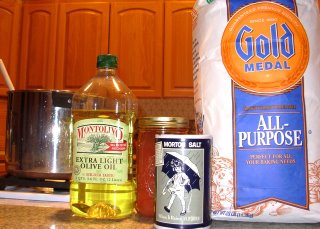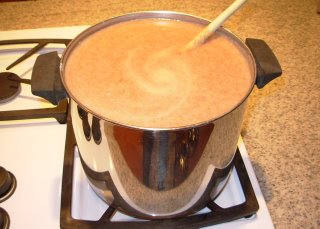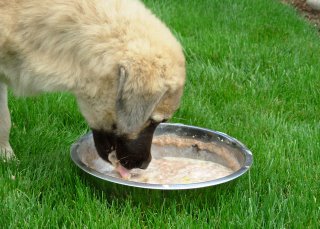Recipe for Yal
Yal is the traditional dog food fed to Anatolian Shepherd dogs in Turkey. The recipe I use here was obtained from a Turkish gentleman who owns Anatolians. I'm sure there are as many variations on this recipe as there are cooks. I'd be very interested to hear about other Yal recipes!
as there are cooks. I'd be very interested to hear about other Yal recipes!
To cook for one dog, use an 8 quart heavy-duty pan. Put in 5 cups each of wheat bran and all-purpose flour. Slowly whisk in cold water until smooth and pan is almost filled. Add 2 to 3 glugs of olive oil and about 1/2 teaspoon of salt. The mixture will boil up a bit, so leave bubble-up room and stirring room.
 Using a tall wooden spoon (mixture gets very hot), stir almost constantly until mixture has boiled for one minute. Yal should be of a thick soup or oatmeal consistency, so it takes most of the day to cool. After one large metal dog dish is filled, save the extra Yal and refrigerate it. In a few days you'll have another dog meal and be able to give yourself a cooking break !
Using a tall wooden spoon (mixture gets very hot), stir almost constantly until mixture has boiled for one minute. Yal should be of a thick soup or oatmeal consistency, so it takes most of the day to cool. After one large metal dog dish is filled, save the extra Yal and refrigerate it. In a few days you'll have another dog meal and be able to give yourself a cooking break !
 Yal is best if you add "healthy" leftovers, like old broth or tomato-based things like spaghetti sauce. Also keep all vegetable peelings and boil them until soft, adding both the vegetables and the cooking water to the Yal. I add everything I can, even poached egg water.
Yal is best if you add "healthy" leftovers, like old broth or tomato-based things like spaghetti sauce. Also keep all vegetable peelings and boil them until soft, adding both the vegetables and the cooking water to the Yal. I add everything I can, even poached egg water.
 Here is my 4 month old Anatolian enjoying his breakfast today! His Yal had a jar of home-canned tomatoes cooked into it. Then some fresh goat milk and a fresh egg were stirred in before serving.
Here is my 4 month old Anatolian enjoying his breakfast today! His Yal had a jar of home-canned tomatoes cooked into it. Then some fresh goat milk and a fresh egg were stirred in before serving.
Yal is not the sole diet for Anatolians in Turkey. They are often fed fresh whole milk and a fresh raw egg or two. Once a week or so, they get a chunk of raw meat.
 as there are cooks. I'd be very interested to hear about other Yal recipes!
as there are cooks. I'd be very interested to hear about other Yal recipes!To cook for one dog, use an 8 quart heavy-duty pan. Put in 5 cups each of wheat bran and all-purpose flour. Slowly whisk in cold water until smooth and pan is almost filled. Add 2 to 3 glugs of olive oil and about 1/2 teaspoon of salt. The mixture will boil up a bit, so leave bubble-up room and stirring room.
 Using a tall wooden spoon (mixture gets very hot), stir almost constantly until mixture has boiled for one minute. Yal should be of a thick soup or oatmeal consistency, so it takes most of the day to cool. After one large metal dog dish is filled, save the extra Yal and refrigerate it. In a few days you'll have another dog meal and be able to give yourself a cooking break !
Using a tall wooden spoon (mixture gets very hot), stir almost constantly until mixture has boiled for one minute. Yal should be of a thick soup or oatmeal consistency, so it takes most of the day to cool. After one large metal dog dish is filled, save the extra Yal and refrigerate it. In a few days you'll have another dog meal and be able to give yourself a cooking break ! Yal is best if you add "healthy" leftovers, like old broth or tomato-based things like spaghetti sauce. Also keep all vegetable peelings and boil them until soft, adding both the vegetables and the cooking water to the Yal. I add everything I can, even poached egg water.
Yal is best if you add "healthy" leftovers, like old broth or tomato-based things like spaghetti sauce. Also keep all vegetable peelings and boil them until soft, adding both the vegetables and the cooking water to the Yal. I add everything I can, even poached egg water. Here is my 4 month old Anatolian enjoying his breakfast today! His Yal had a jar of home-canned tomatoes cooked into it. Then some fresh goat milk and a fresh egg were stirred in before serving.
Here is my 4 month old Anatolian enjoying his breakfast today! His Yal had a jar of home-canned tomatoes cooked into it. Then some fresh goat milk and a fresh egg were stirred in before serving.Yal is not the sole diet for Anatolians in Turkey. They are often fed fresh whole milk and a fresh raw egg or two. Once a week or so, they get a chunk of raw meat.

7 Comments:
I was curious about what these dogs were fed in Turkey and Janice at Semavi Anatolians was kind enough to direct me here. I spent many years in Turkey growing up and remember these magnificent farm dogs (I have Rottweilers now but maybe one day if I have more space...)
I wonder where the dogs get calcium in that diet, though? Do you know?
My understanding is that traditionally whatever scraps are put into the gruel are part of whatever else the dog scrounges up. They get eggs with the shells, raw meat, bones and organs if there is some to give them. Whey from cheesemaking and milk as well. I understand that the few puppies not culled would get extra nutritional attention.
Small rodents, large insects, discovery of nests with eggs, captured birds, reptiles, as well as livestock manure are part of the dietary supplements to which working dogs have access. They chew on sticks and chunks of wood, garbage and whatever they find, so their access to things is not as limited as say, dogs that are raised as part of a household in a fenced yard area.
We know present day working dogs on farms do scavenge and browse during the day, especially younger dogs who have more energy requirements anyway.
Nowadays, dogs living in closed kennels or in chained holdings will not get as much variety in this additional stuff. I suspect that the popular strains of dogs kept by wealthier people and in enclosed areas are getting more left overs or commercial foods added to their meals.
Like everything else that has been taken for granted, I guess this is an area at which we could look more closely.
Ray Coppinger wrote that Maremma Sheepdogs that he and Jay Lorenz studied were sustained primarily on oatmeal and whey. So I think these are bulk giving things and flock guardians scrounged a bit on their own.
There isn't that much information on the longevity of traditionally raised flockguardians. I run into case stories and conjectures, so I guess all I can gather is a collage of sorts. :)
Ah....I have the Coppinger book, hadn't thought to look there. As well as many formative years in Turkey, I lived in Scotland (my mother still lives there and has sheep, we had several working BCs.) Sheepdogs are also fed oatmeal-based food and meat scraps; "liver and lights" from butchers. I recall one being an avid mouse hunter, too. The commercial food we fed from the crofters' store was oats and fish meal based.
In Scotland no dog was EVER fed mutton or lamb. Strictly verboten for fear they would get the idea of eating their flocks!
I am so sad my beautiful Black Lab/ Anatolian Maggie died a few weeks ago of severe cancer at age 6. She was 120# such an incredible friend and companion. I wish I had read this - I am actually a vegan. I always fed her raw meat as I along with some soup / veggies and a little grain free dog food. Now I realize this may have been the opposite of how her breed has traditionally been raised. I wish I had her back... I wish I had fed her this vegan diet. Thank you for posting this.
Maggie would also catch and munch down a prairie dog - in a heartbeat when she was young - so I know she had the scavenging in her too - I wish I had fed her vegan and let her scavenge.
I see this post was written in 2006, now that over nine years have elapsed, do you still recommend YAL?
Since trying yal with several litters over the years, I have learned that yal is not the best diet for pups. Feeding raw requires paying close attention to the calcium phosphorus balance in the foods fed. According to Pat Hastings, the only raw meat that is balanced in this regard, is poultry necks. One other food she indicated is balanced is raw eggs, but only if the shell is ground up and added to the egg. For more information on feeding raw, I suggest an online search for feeding puppies raw and the calcium phosphorus balance. Wishing everyone healthy puppies!
Chyril
Post a Comment
<< Home